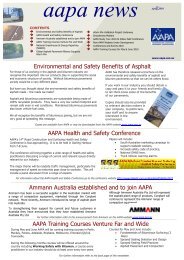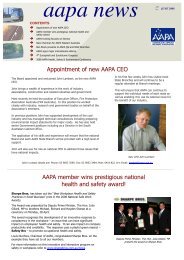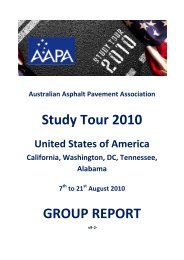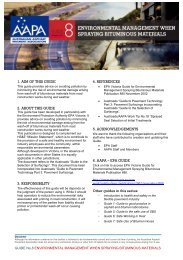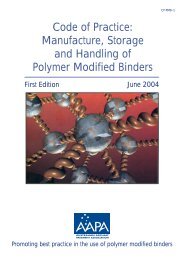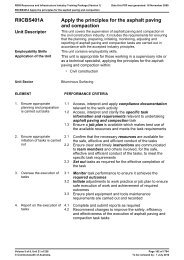Asphalt Review - Volume 29 Number 2 (June / July 2010)
Asphalt Review - Volume 29 Number 2 (June / July 2010)
Asphalt Review - Volume 29 Number 2 (June / July 2010)
Create successful ePaper yourself
Turn your PDF publications into a flip-book with our unique Google optimized e-Paper software.
ASPHALT REVIEW NEWS<br />
Replacing load-bearing ballast with asphalt was used for the<br />
first time in Germany around 25 years ago, with an asphalt<br />
base course. Since then, seven different systems of the asphalt<br />
construction method have been developed and constructed in<br />
Germany.<br />
Requirements for the asphalt layers<br />
In general, the requirements for the asphalt are determined<br />
by the load type. In the case of the solid railway trackbed,<br />
loading frequency is at a lower level than with asphalt roads.<br />
In contrast, the axle loads, and consequently the wheel loads,<br />
are far higher. On roads, the actual distributed load results<br />
in a wheel load of 5.75 tons for a truck with an 11.5-ton axle,<br />
which works out to around 0.8 MPa for a surface area of<br />
around 710 cm². For railways, however, there is a considerable<br />
load distribution over the rail and the sleeper. The wheel load<br />
of 11.25 tons results in stress on the bottom of the sleeper of<br />
around 0.25 MPa, and thus only around one-third of the load<br />
experienced on roads.<br />
The asphalt needs to be designed to be permanent, flexible<br />
and dense in order to avoid the need for maintenance work<br />
and subsequent improvements. The lifetime of the solid<br />
railway trackbed has been estimated to be around 60 years.<br />
Experience in Germany has shown that asphalt types with a<br />
high binder content and a low void content have proven to be<br />
reliable.<br />
Advantages<br />
The solid railway trackbed laid in Germany to date has been<br />
shown to be very successful due to the reliability of the paving<br />
and by the material-specific characteristics of the asphalt:<br />
• <strong>Asphalt</strong> can be paved without joints due to its visco-elastic<br />
characteristics; stresses arising from the effects of load and<br />
temperature are reduced.<br />
• <strong>Asphalt</strong> can also be used with extreme super-elevation<br />
because no separation arises from the high internal friction<br />
in the paved state.<br />
• <strong>Asphalt</strong> can be paved at a precise tolerance (± 2 mm) due to<br />
its material characteristics.<br />
• Load can be put on the asphalt immediately after it cools<br />
down; shorter construction times are achieved because of<br />
this.<br />
• Corrections in the position that may be needed (e.g. due<br />
to settlement of the embankment) can be quickly and easily<br />
made either by milling off or by putting on another layer.<br />
The preceding article highlights some of the Europe<br />
experience in using asphalt in rail track construction. In<br />
Australia asphalt has not been used, but with the increasing<br />
demands on our rail network and with the construction of<br />
new railways, the Australian Transport industry should look<br />
at the advantages of asphalt.<br />
The use of asphalt in the construction of tram lines also<br />
offers many potential advantages including smoother rides,<br />
lower noise, quick track rehabilitation and maintenance times<br />
and potentially less maintenance of wheels and suspensions.<br />
If there is interest in using asphalt in railways or tramways,<br />
AAPA will consider inviting experts from both Europe and the<br />
US to participate in workshops to discuss the technical and<br />
commercial advantages of this material.<br />
For further information about EAPA and contact details<br />
refer to www.eapa.org<br />
SAMI expands its boundaries<br />
May 5, <strong>2010</strong>, saw the opening of SAMI Bitumen Technologies’<br />
new bitumen import terminal facility at the Port of Brisbane.<br />
The terminal complements the company’s high standard of<br />
product and service delivery, and significantly expands its<br />
reach.<br />
Bulk bitumen is usually imported into Brisbane from Asia<br />
via purpose built ships and the new bitumen storage and<br />
processing terminal facility has a pipeline that connects the<br />
bulk storage tanks to the new general purpose wharf. But it’s<br />
not simply about making the process of unloading and storage<br />
easier.<br />
SAMI’s new import terminal incorporates some of the most<br />
advanced technology of its kind in the world. The facility is<br />
capable of producing a variety of high performance bitumen<br />
grades used in road construction and maintenance, as well as<br />
bitumen product for various industrial applications.<br />
This one-stop import and production approach makes the<br />
terminal one of the most efficient in Australia. It is in addition<br />
to the company’s terminals at Geelong in Victoria and at North<br />
Fremantle in Western Australia.<br />
Pioneering new technologies has been part and parcel of the<br />
SAMI approach to business since the company’s inception 32<br />
years ago. In 1978, it was formed because there was a need to<br />
develop new technology; a way by which a polymer modified<br />
bitumen could be used as a stress absorbing membrane interlayer<br />
under asphalt overlays in road pavements.<br />
SAMI not only succeeded in developing a polymer modified<br />
bitumen for use as a sprayed seal and as an asphalt overlay<br />
binder, but also created a new market in Australia. This was<br />
just the beginning for SAMI and from that starting point<br />
the company focused its resources on developing innovative<br />
road technologies, products and securing other contracting<br />
services.<br />
In 2008, SAMI significantly expanded its global reach beyond<br />
Australia by establishing a formal collaborative relationship<br />
with Colas SA. It was a natural development as SAMI had<br />
been exchanging technical information over the previous 16<br />
years with the French company in what was described at the<br />
time as a ‘long term mutual courtship’.<br />
Interestingly, there were other similarities between the<br />
two companies. Both Colas and SAMI are company names<br />
that have their origin in the innovative products created by<br />
each entity and both companies began life in the pursuit of<br />
a bitumen related solution which led to the creation of those<br />
particular products.<br />
Bulk Bitumen Cargo being off loaded at the General Purpose wharf,<br />
Port of Brisbane<br />
42 ROADS JUNE <strong>2010</strong>/JULY <strong>2010</strong>



